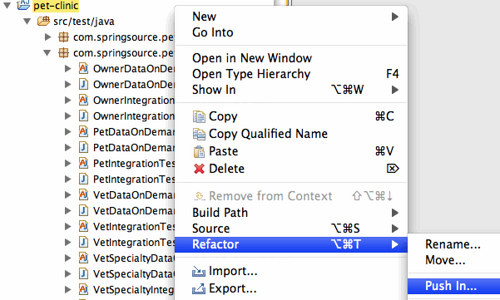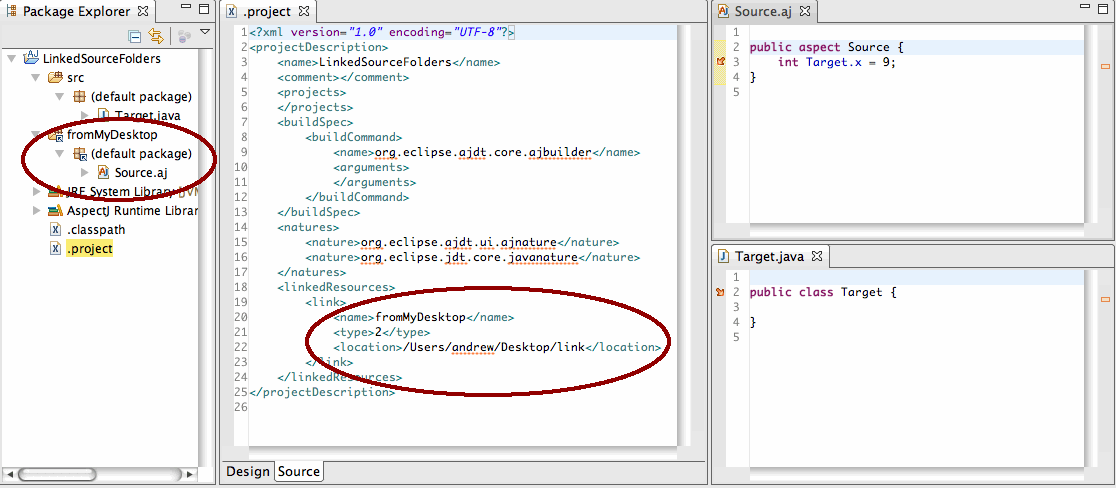and new versioning scheme
All these changes so far have been crammed into 1.6 maintenance releases due to the tradition of pegging AJDT minor versions (e.g., 1.6) to Eclipse minor versions (e.g., 3.4). We now believe that this tradition has outlived its usefulness and is proving to be more confusing than helpful for users. For the current and future releases of AJDT, we have decided to move towards a more common use of versioning based on feature and API changes.
From now on, changes to the micro part of the version number will indicate only trivial functionality changes and bug fixes. Changes to the minor part of version number will indicate that no major functionality or API has been introduced or changed. And changes to the major part of the version number will indicate that the new version has some significant enhancements in it.
AJDT releases targeting different Eclipse versions will use the same
major.minor.micro scheme, but
there will be a noticeable difference in the qualifier. For example:
| Release for AJDT targeting Eclipse 3.5: | 2.0.0_e35x2009XXXXXX |
| Release for AJDT targeting Eclipse 3.4: | 2.0.0_e34x2009XXXXXX |
So this means that AJDT 1.6.5 has been renamed AJDT 2.0.0_e34x and AJDT 1.7.0 has been renamed AJDT 2.0.0_e35x. Although this is potentially confusing in the short term, we believe in the long term, this will be more informative and users will be able to read the version and immediately know which Eclipse version it targets and also what feature level it contains.
With that important bit of information explained, below are the bug fixes and new features introduced in the 2.0 release since AJDT 1.6.4.
Hovering over a method that is declared as an ITD will display the JavaDoc of that method:

Similarly, pressing F3 or CTRL-Click on an identifier that is declared as an ITD will navigate to the ITD's declaration:
 |  |  |
For more information, see Bug 273334.
Note, like all other ITD awareness support, a successful build since the last restart of the workspace is required.
Essentially, the refactoring pushes intertype declarations into their target types. So, when a push in refactoring is applied to the following aspect and class:
aspect Foo {
int Bar.x;
declare parents : Bar implements I;
declare @type : Bar : @Baz;
}
class Bar { }
the result is:
The Foo aspect is deleted because it is empty.
@Baz
class Bar implements I {
int x;
}
This refactoring is available from the package explorer, the outline view, and wherever else Java elements appear in a hierarchy. To use, select the ITDs or set of ITDs that you want to push in. You can select an entire project, source folder, or package to push all of its ITDs into the target types:

See AJDT's blog for a detailed explanation of the refactoring.

Note that we do not support displaying advice relationships on the inpath, nor do we show the inverse relationship on the inpath. See Bug 273086 and Bug 273087 respectively.
More information can be found in Bug 271269.

Note that we typically recommend using linked source folders instead of inpath relationships where possible. The reason is that the AspectJ compiler can perform better incremental analysis on linked folders than it can with inpath folders. This is because linked folders are considered part of the source of project and the compiler stores more specific state on these kinds of folders.
More information can be found in Bug 253555 and Bug 275903.

in the AJDT Event Trace view.
For example, the hierarchy and relationship map for the DeclareParents on Inpath project displayed above is:
9:2:18 Printing crosscutting model for all AspectJ projects in the workspace
9:2:18
9:2:18 --------------------------------------
9:2:18 Printing crosscutting model for DeclareParents on Inpath
9:2:18
Hierarchy:
=DeclareParents on Inpath/src
=DeclareParents on Inpath/src<
=DeclareParents on Inpath/src<*A.aj
=DeclareParents on Inpath/src<*A.aj#
=DeclareParents on Inpath/src<*A.aj}A
=DeclareParents on Inpath/src<*A.aj}A[E
=DeclareParents on Inpath/src<*A.aj}A`declare parents
=DeclareParents on Inpath/src<*A.aj}A)C.x
Relationship map:
=DeclareParents on Inpath/src<*A.aj}A)C.x ::
=DeclareParents on Inpath/src<*A.aj}A)C.x --declared on--> [=DeclareParents on Inpath/,<(C.class[C]
=DeclareParents on Inpath/,<(C.class[C ::
=DeclareParents on Inpath/,<(C.class[C --aspect declarations-->
[=DeclareParents on Inpath/binaries<*AnotherAspect.aj}AnotherAspect`declare parents,
=DeclareParents on Inpath/src<*A.aj}A`declare parents, =DeclareParents on Inpath/src<*A.aj}A)C.x]
=DeclareParents on Inpath/src<*A.aj}A`declare parents ::
=DeclareParents on Inpath/src<*A.aj}A`declare parents --declared on--> [=DeclareParents on Inpath/,<(C.class[C]
9:2:18 --------------------------------------
The information spit out here corresponds to internal handles used by AspectJ and AJDT to
describe the crosscutting relationships in a project. These handles correspond to program elements
that represent things like advice declarations, method declarations, source folders, etc.
Although this feature is meant for diagnostic purposes,
it can be used to introspect your project and help you understand a little more about AJDT and AspectJ internals.
Warning: the crosscutting model can be large and dump significant amount of text to the Event Trace view.
More information can be found in Bug 271668
<plugin>
<groupId>org.apache.maven.plugins</groupId>
<artifactId>maven-eclipse-plugin</artifactId>
<version>2.5.1</version>
<configuration>
<additionalBuildcommands>
<buildCommand>
<name>org.eclipse.ajdt.core.ajbuilder</name>
<arguments>
<aspectPath>org.springframework.aspects,org.springframework.aop</aspectPath>
</arguments>
</buildCommand>
</additionalBuildcommands>
<additionalProjectnatures>
<projectnature>org.eclipse.ajdt.ui.ajnature</projectnature>
</additionalProjectnatures>
</configuration>
</plugin>
Inside the arguments element, specify a comma separated list of aspectPath elements. The
builder then looks for any jar file or binary folder on the raw classpath that contains the specified string. So,
the above would add any of org.springframework.aspects_2.5.1.jar, org.springframework.aspects_3.0.0.jar,
or org.springframework.aop_2.5.1.jar onto the aspect path of the project if the jar files already
exist on the classpath.
Note the use of version 2.5.1. Unfortunately, version 2.6 of the Maven-Eclipse-Plugin does not support AJDT. Version 2.7 should fix this problem.
More information can be found in Bug 270552, Bug 270554, and MECLIPSE-538.

In this second image, the content assist inside of Point does not show the logger field, but still shows the getX and getY methods.

More information can be found in Bug 272547
Also, AJDT is spreading. The Scala-Eclipse plugin is now using JDT Weaving to make its JDT integration deeper and more robust.